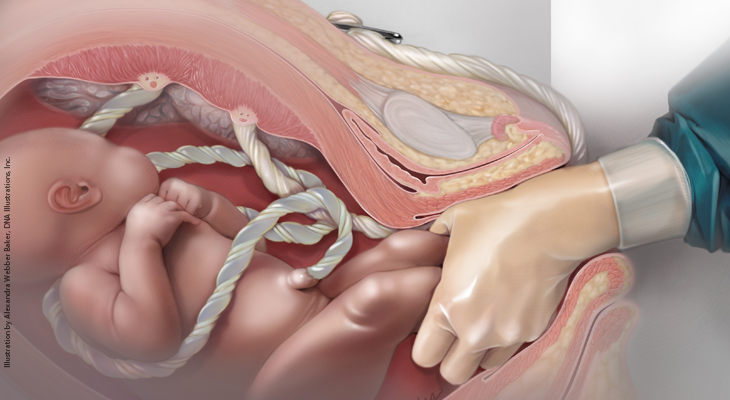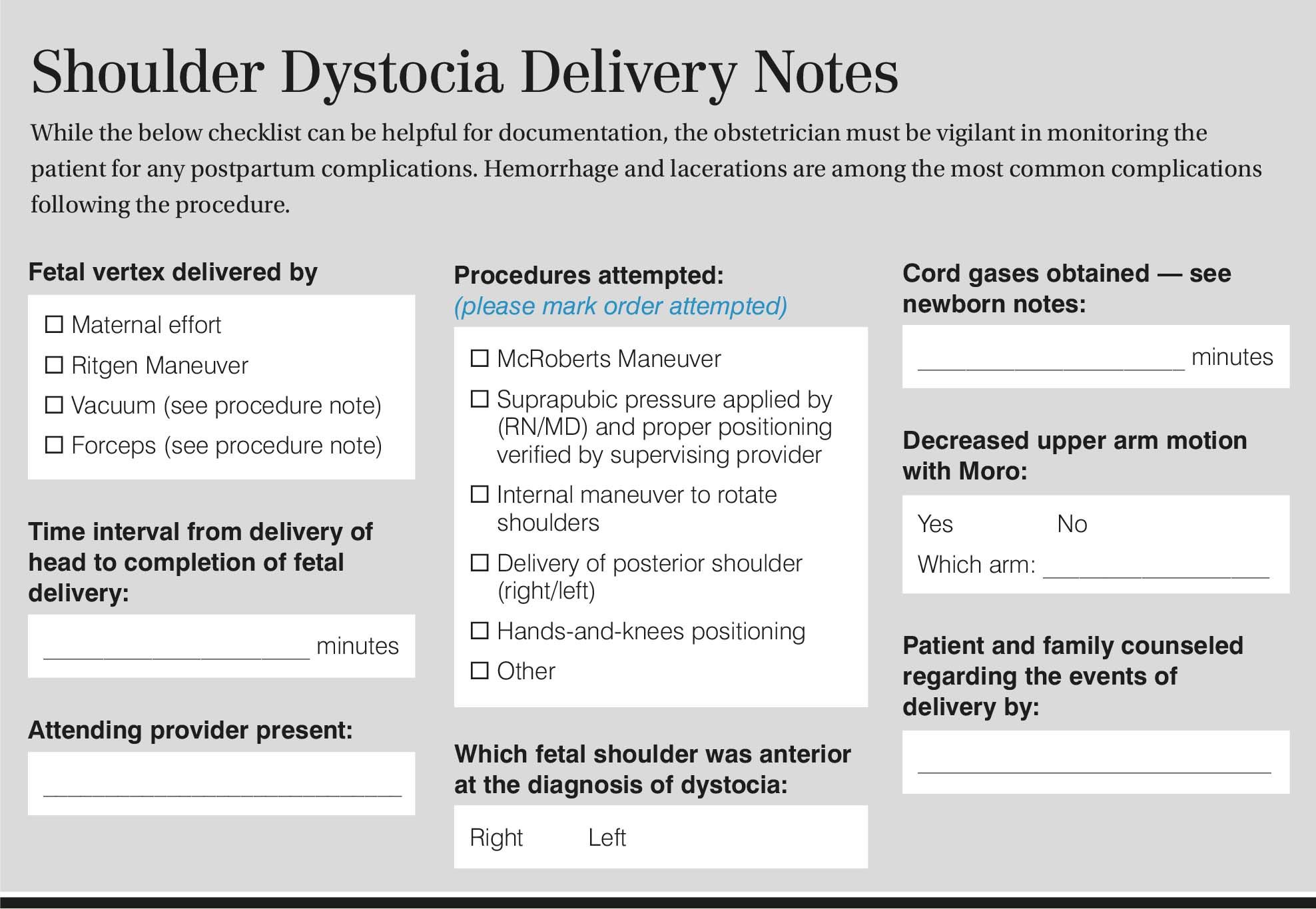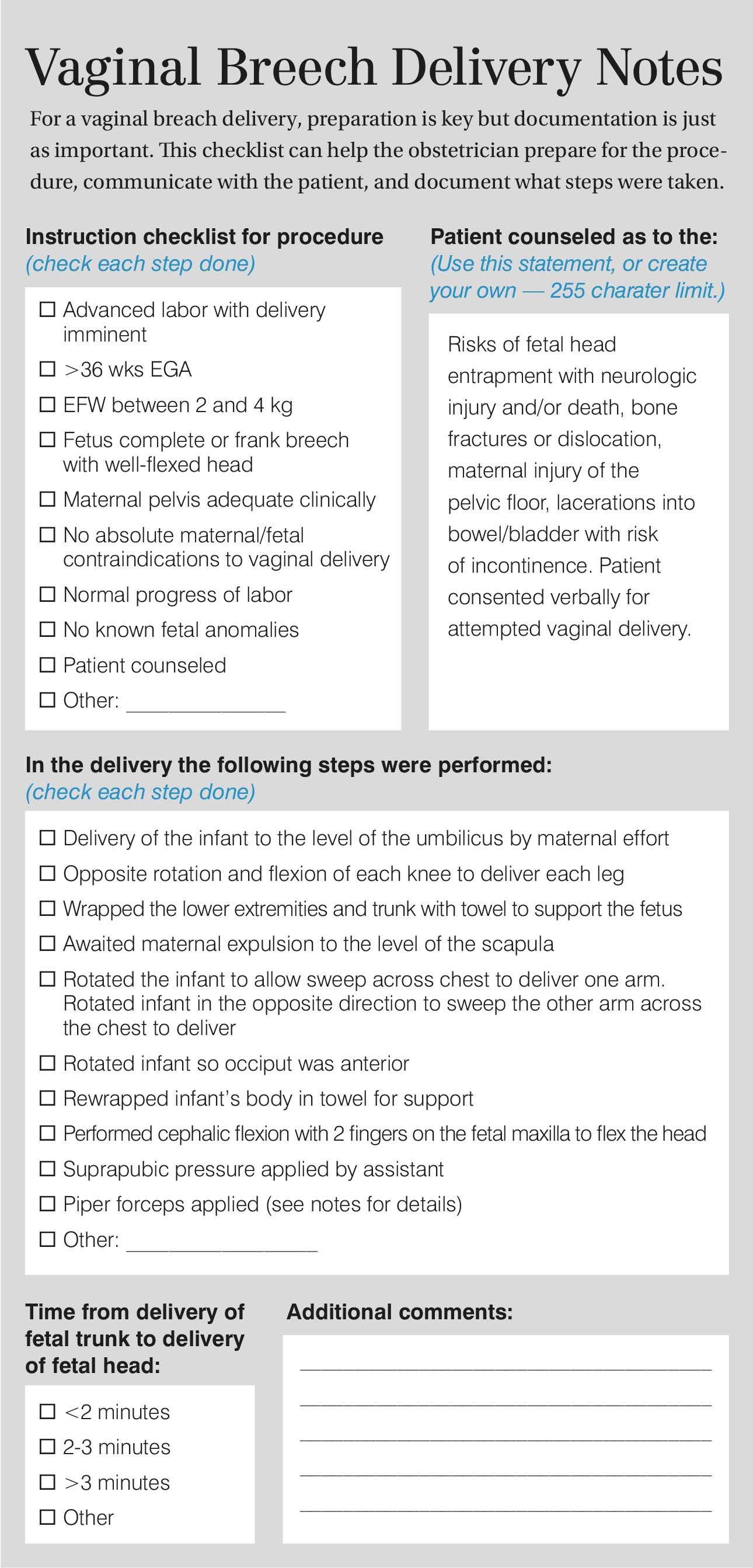How to minimize vaginal birth complications
There are several concrete steps clinicians can take to lessen the likelihood of vaginal birth complications, whether stemming from shoulder dystocia, a second twin or vaginal breech.
Illustration by Alexandra Webber Baker, DNA Illustrations Inc. Click here to see more of her work.

There are several concrete steps clinicians can take to lessen the likelihood of vaginal birth complications, whether stemming from shoulder dystocia, a second twin or vaginal breech.
Having a protocol in place and simulation rehearsing with the entire medical team are two techniques proven to reduce complications.
“Often these complications are unexpected,” said Contemporary OB/GYN Editor-in-Chief Charles J. Lockwood, MD, MHCM. “For example, with shoulder dystocia, it is extremely difficult to predict who is at risk. And even when you predict those at risk, the patient usually does not have shoulder dystocia.”
Shoulder dystocia
Because a shoulder dystocia is typically unanticipated, “it is critical that clinicians have in mind a set protocol of steps to take in order to optimize outcomes,” said Dr. Lockwood. “It is also really important to document what you did and why you did it, so you have a credible defense, should there be an adverse outcome and you end up being sued.”
Shoulder dystocia occurs when the fetal head delivers but the shoulders do not deliver with normal maneuvers. It is one of the few emergencies encountered during labor that an urgent cesarean delivery or surgery cannot correct.
Hence, shoulder dystocia needs to be remedied with the maneuvers that the obstetrician is already trained in, according to Amy Mackey, MD, ob/gyn Residency Program Director at Abington Hospital-Jefferson Health in the Philadelphia area. Simulation and team training can also lessen some of the anxiety surrounding the event.
Incidence of shoulder dystocia ranges between 0.2% and 3%. “This wide range is due to subjectivity at the time of delivery as to what constitutes a shoulder dystocia,” said Dr. Mackey. “The definition that most people follow is a difficult shoulder delivery that does not resolve with gentle downward traction and requires additional obstetric maneuvers.”
A previous shoulder dystocia during delivery is the strongest risk factor. Other risk factors include operative delivery, maternal obesity, maternal diabetes, fetal macrosomia, a prolonged second stage and a precipitous delivery.
When encountering a shoulder dystocia, the positioning of the mother is the first consideration. “The patient should be brought down on the bed, so that the bed does not obstruct your ability to perform gentle, downward traction,” Dr. Mackey told Contemporary OB/GYN. “Also, make sure you have a stool in the room and that you have someone ready to exert suprapubic pressure. That team effort is really important, so preparation is key.”
In addition, the axis of the force applied for downward traction is important to decrease the strain on the brachial plexus.
Dr. Mackey said it is important not to panic when a shoulder dystocia is encountered. “Force is measured in newtons, which has an exponential time component in the denominator,” she said. “The faster you apply pressure to the baby’s neck, the greater the force will be on the brachial plexus. Therefore, slow and gradual increase in pressure will be better tolerated by the fetus.”
Some physicians advocate delivering the posterior arm after performing the McRoberts Maneuver and suprapubic pressure as better than rotational maneuvers to alleviate shoulder dystocia. “But this is controversial,” said Dr. Mackey. “It really depends on the clinical situation.”
Dr. Mackey said the order of the maneuvers is less important than having a standardized approach. “You want everyone in the room to be able to anticipate what will happen next,” she said. “For us, the provider repeats all the maneuvers. If the provider is still unsuccessful at achieving delivery, a second provider tries.”
Dr. Mackey said obstetricians should never exert fundal pressure. “There is a higher incidence of permanent brachial plexus injury if you use fundal pressure at the time of a vaginal delivery with shoulder dystocia,” she said.
The maneuvers performed for shoulder dystocia are intended to prevent hypoxic injury to the baby. “The time that you have from the time you encounter shoulder dystocia to the time that the baby needs to be delivered is variable, based on the status of the baby going into the delivery,” said Dr. Mackey. “For example, if you have a baby that is well-oxygenated, you are going to have more time than if you have a baby that is borderline to relieve the shoulder to prevent hypoxic injury.”
Once a shoulder dystocia is resolved, the obstetrician must stay alert to postpartum complications. “Postpartum hemorrhage and third- and fourth-degree lacerations are increased in women who experience a shoulder dystocia,” said Dr. Mackey.

Second twin
In contrast to shoulder dystocia, a second twin is more often than not an anticipated potential complication. “The problem often results from an unstable lie,” Dr. Lockwood said. “In other words, as the second twin is coming down, you might think it is coming down vertex and then it flips, or it might be coming down breech and then it becomes transverse. The challenge is understanding the fluidity of that situation.”
As with shoulder dystocia, having a plan in place for effectively delivering that second twin is critical, whether that be an internal podalic version, an external version or a normal vaginal delivery in the vertex position.
“You want to also ensure that there is an adequate medical team available, including enough staff to perform a stat C-section, if needed,” Dr. Lockwood said. “In addition, there needs to be someone to help guide the second twin into the pelvis and someone to monitor the heart rate and other vital signs.”
Delivering the second twin can be tricky, according to Dr. Lockwood. “You can have ruptured membranes, or the umbilical cord can prolapse or present before the baby,” he said. “Occasionally there is even vasa previa and other complications that necessitate rapid action.”
Again, documentation is also key.
Prevalence of vaginal delivery of twins, both vertex and breech, has increased over the years at Brigham and Women’s Hospital in Boston, paralleling a decrease in incidence of cesarean birth, possibly due to a comprehensive program entailing patient counseling, staff simulation training and an available team for twin deliveries.
“Although the literature about the delivery of twins is understandably limited, we believe that vaginal delivery is generally a safe thing to do,” said Julian Robinson, MD, Chief of Obstetrics at Brigham and Women’s Hospital, in Boston. “However, there is no optimal technique that can be used for delivery of the second twin. Furthermore, the choice of technique may change as the case progresses.”
Dr. Robinson told Contemporary OB/GYN that traditionally, obstetricians tend to favor a single technique for all situations.
Dr. Robinson counsels families that if the first twin is breech, both twins are delivered via cesarean. But if the first twin is head down, a vaginal delivery is planned for both twins, unless there is a good reason not to do so, such as the second twin being much larger than the first.
“We also factor in maternal wishes,” said Dr. Robinson. “For example, if the mother is very keen on having a C-section delivery rather than a vaginal delivery, we honor that request.”
In the case of both twins being head down, one approach is to be fairly hands off. “You deliver the first baby and then stabilize the lie of the second baby, head down,” said Dr. Robinson. “You actually let the second baby labor down before rupturing the membranes, so the head is well engaged.”
This approach is much more suitable for mothers who have previously delivered. “But for the mother who has not had a baby before, we are more proactive with early rupture of the membranes,” said Dr. Robinson.
In this scenario, Dr. Robinson rarely uses a high vacuum to pull the baby down quickly (a technique that he used to use preferentially) because the vacuum tends to disengage, plus it avoids two different instruments for vaginal delivery, such as vacuum and forceps.
A second method to consider is to deliver the first twin vaginally and the second twin breech, if the head of the second twin is high but surrounded by amniotic fluid. “You change the second baby to a breech presentation by an internal podalic version for an almost instantaneous delivery,” said Dr. Robinson.
Dr. Robinson said mothers do not want a vaginal delivery of the first baby and a cesarean for the second. “What increases the probability of a C-section is the length of time between the delivery of the first and second baby,” he said. “The longer the wait, the more likely something will go wrong, like bleeding or a nonreassuring fetal heart rate, which precipitates intervention with a C-section.”
Organization and planning ahead are key to increasing the odds of a vaginal delivery of twins. What are the roles of each member of the obstetric team? What does the mother want?
Logistically, will the twins be delivered in a labor room or the operating room (OR)? “Personally, I tell all my patients we are going to deliver in the OR, not because we think there is going to be an increased chance of an operation, but because we want the space,” said Dr. Robinson. “It takes a lot of room, particularly when you bring in two separate pediatric teams.”
Vaginal breech
Independent of twins, with breech birth there is always the possibility of a woman presenting to labor and delivery fully dilated with the breech at the perineum, in which case there is no time for a cesarean. “Therefore, it is important in that circumstance to know how to deliver the vaginal breech,” Dr. Lockwood said.
Similarly, in the case of a woman desiring a planned vaginal breech delivery, the clinician should aim for a good outcome that is safe.
“Sometimes you can have trouble delivering breeches at C-section, so having a good C-section technique available is also important,” Dr. Lockwood said.
Documenting every aspect of the delivery, whatever the means, is critical.
Learning several simple skills can make a breech birth safer for both mother and baby. “Upright vaginal breech is actually an easier way to deliver the babies breech,” said Annette Fineberg, MD, an ob/gyn at Sutter Medical Group in Davis, Calif. “Gravity, combined with 1 to 2 cm of extra space, results in rarely needing forceps or complicated maneuvers.”
Dr. Fineberg told Contemporary OB/GYN that when the baby is in the upright position, gravity helps the baby be born. “The baby is able to rotate and flex on its own,” she said. “By knowing what is supposed to happen, you then know when to intervene. A lot of times, the birth will happen on its own. In essence, hands off the breech, unless there is a danger sign.”
Many of the tips Dr. Fineberg shared originate from Frank Louwen, MD, an ob/gyn in Frankfurt, Germany, and his colleagues.
In the case of a surprise breech, when the mother is starting to deliver, “it is best for the mother to get on her hands and knees,” said Dr. Fineberg. “The baby will then perform specific maneuvers to get itself out. If the baby does not rotate properly, you know there is a problem.”
Likewise, if there is no crease in the baby’s chest, “you may need to do a Løvset maneuver to retrieve a nuchal arm,” said Dr. Fineberg.
“The baby has a limited time to get out. With a reassuring fetal heart rate and a vigorous infant, you have about five minutes,” said Dr. Fineberg.
Conversely, ob/gyns need to know when to abandon a breech birth and deliver by cesarean instead. “If the baby is not following the expected rotation and descent, you are probably better off pushing the baby up,” said Dr. Fineberg.
Dr. Fineberg has heard numerous stories of mothers being placed at risk, when in reality the baby was simply trying to come out on its own. “For example, a mother having her fifth baby at 36 weeks is put under general anesthesia after a full meal,” she said. “If the mother had been able to push instead, the baby probably would have been born in five minutes.”
Good candidates for vaginal breech delivery are mothers who are at least 36 to 37 weeks’ pregnant, frank or complete breech, spontaneous labor progressing, normal descent, adequate pelvis and an estimated fetal weight between 2,500 and 4,000 g.
“MRI pelvimetry is not absolutely needed, but it can decrease the odds of needing an intrapartum cesarean,” said Dr. Fineberg.
A growth-restricted or preterm baby is actually more dangerous for breech delivery than a large baby because the body can be small and the head bigger in proportion.
For an unplanned breech birth, the two signs of an adequate pelvis are rapidly progressing cervical dilation and rapid decent of the baby. “You should also check the fetal head position with ultrasound,” said Dr. Fineberg.
One newer technique to increase safety during breech delivery is a shoulder press, “You apply pressure at the midclavicular line, which causes a reflexive tuck of the chin,” said Dr. Fineberg.
Most obstetricians learn to perform a routine episiotomy for breech, especially with a first-time birth. “But an intact perineum can often help the baby flex its own head,” said Dr. Fineberg.
Many studies published since 2000 have been encouraging about risk of a vaginal breech. “There is no question that vaginal breech babies have lower Apgar scores than C-section babies, but the incidence of serious long-term complications is not significantly different between the two techniques,” said Dr. Fineberg.
Based on more recent optimistic clinical studies, organizations in UK, Canada and the American College of Obstetricians and Gynecologists (ACOG) now have published more positive breech guidelines. In August, ACOG issued an interim update of its committee opinion on term singleton breech delivery (https://www.acog.org/Clinical-Guidance-and-Publications/Committee-Opinions/Committee-on-Obstetric-Practice/Mode-of-Term-Singleton-Breech-Delivery). “The main problem, though, is that most obstetricians have not learned how to deliver babies breech,” said Dr. Fineberg.
For an unplanned breach or an emergency situation, “I want the ob/gyn to feel more safe and comfortable performing a vaginal breech,” said Dr. Fineberg said. “I would also like to see referral centers, so mothers have an option.”
For all vaginal birth complications, training the entire staff with simulation year-round is vital, “so when the actual emergency occurs, the staff is ready and knows exactly what to do,” Dr. Lockwood said. “The team is prepared to proceed in a very orderly and logical fashion, with a minimum of chaos. That will minimize errors.”
Likewise, for all scenarios, “you want to have a protocol in mind that is burned and seared into your memory,” Dr. Lockwood said. “You do not want to panic when confronted with any of these emergencies.”

Disclosures:
Dr. Mackey reports no relevant financial disclosures.
Dr. Robinson reports no relevant financial disclosures.
Dr. Fineberg reports no relevant financial disclosures.
Dr. Lockwood is the editor-in-chief of Contemporary OB/GYN magazine.
References:
- Mode of term singleton breech delivery. ACOG Committee Opinion No. 745. American College of Obstetricians and Gynecologists. Obstet Gynecol. 2018;132:e60–3.
- American College of Obstetricians and Gynecologists’ Committee on Practice Bulletins-Obstetrics. Practice Bulletin No. 178: Shoulder Dystocia. Obstet Gynecol. 2017 May;129(5):e123-e133.
- American College of Obstetricians and Gynecologists’ Committee on Practice Bullets-Obstetrics. Practice Bulletin No. 161: External Cephalic Version. Obstet Gynecol. 2016 Feb;127(2):E54-61.
- American College of Obstetricians and Gynecologists’ Committee on Practice Bulletins-Obstetrics; Practice Bulletin No. 169: Summary: Multifetal Gestations: Twin, Triplet, and Higher-Order Multifetal Pregnancies. Obstet Gynecol. 2016 Oct;128(4):E131-146.
- American College of Obstetricians and Gynecologists’ Committee on Practice Bulletins-Obstetrics. Practice Bulletin No. 178: Shoulder Dystocia. Obstet Gynecol. 2017 May;129(5):e123-e133.
- Whyte H, Hannah ME, Saigal S, Hannah WJ, Hewson S, Amankwah K, et al. Outcomes of children at 2 years after planned cesarean birth versus planned vaginal birth for breech presentation at term: the International Randomized Term Breech Trial. Term Breech Trial Collaborative Group. Am JObstet Gynecol. 2004;191:864–71.
- Hannah ME, Whyte H, Hannah WJ, Hewson S, Amankwah K, Cheng M, et al. Maternal outcomes at 2 years after planned cesarean section versus planned vaginal birth for breech presentation at term: the international randomized Term Breech Trial. Term Breech Trial Collaborative Group. Am J Obstet Gynecol. 2004;191:917–27.
- Su M, Hannah WJ, Willan A, Ross S, Hannah ME. Planned caesarean section decreases the risk of adverse perinatal outcome due to both labour and delivery complications in the Term Breech Trial. Term Breech Trial Collaborative Group. BJOG. 2004;111:1065–74.

S1E4: Dr. Kristina Adams-Waldorf: Pandemics, pathogens and perseverance
July 16th 2020This episode of Pap Talk by Contemporary OB/GYN features an interview with Dr. Kristina Adams-Waldorf, Professor in the Department of Obstetrics and Gynecology and Adjunct Professor in Global Health at the University of Washington (UW) School of Medicine in Seattle.
Listen
Study shows a healthy prenatal diet could be upstream obesity prevention strategy
December 26th 2024"Our findings support the recommendation of a healthy diet based on the current guidelines (as measured by the HEI) during pregnancy, since it may reduce patterns of infant growth outside reference ranges."
Read More
Early pregnancy cannabis use high in states with recreational legalization
November 11th 2024A population-based time-series analysis California before, during and after legalization show a rising trend in women using cannabis while pregnancy especially when the state has legalized the drug.
Read More
